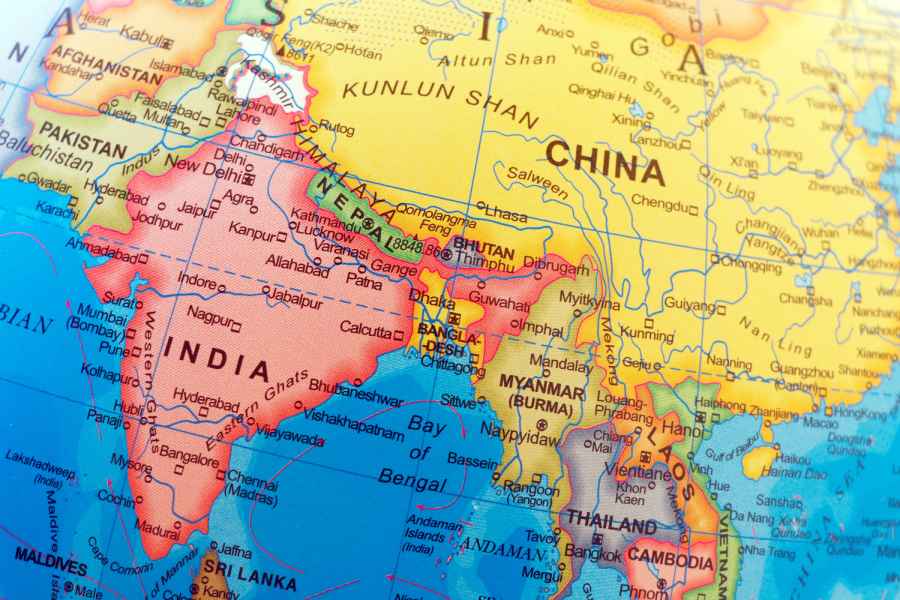 |
| DAHI BHALLE WITH ASIAN SPICES IN SAMBAL OELEK YOGHURT |
One of my favourite haunts in Old Delhi is a hole in the wall called Ashok Chaat Bhandar. You jostle with the crowd in front of it, and if you are patient enough (which you are if you’ve ever eaten there) you will soon be handed over a plate of Ashok’s famous chaat. A bed of papri — fried flat wheat discs — comes with bits of potatoes, boiled chickpeas and soft urad dal balls, smothered in curd and topped with chutneys.
There is something about a plate of chaat that is magical. The various flavours — sour, sweet, hot and bland — together present a taste that’s hard to define. The delicious result of this mélange of flavours tells us how chaat got its name. Old-timers tell me that it comes from the Hindi word for licking — which is what you did to the sal leaf (where chaat was traditionally served) once you had finished eating everything on it.
Twenty years ago, if you’d told me that chaat would change with time, I would have sniggered. Of course, in many parts of the country — especially in the north — chaat is what it always was. It includes everything from golgappas (or phuchkas, as they are called in the East) to dahi pakori (which Punjabis call dahi bhalla) to roasted potatoes tempered with all kinds of delicious spices and aloo tikki — fried potato patties served with a hot chilli-coriander chutney and a sweet tamarind-jaggery sauce.
 |
| TIRUCHIRAPALLI MUSTARD TEMPERED ROOT VEGETABLE PAPRI |
But chaats have been changing with time too. In some places, bottled water has replaced the spiced up tap water that’s used in golgappas and other chaats. There was quite a rage some years ago, when people who liked their street food as much as they enjoyed their vodka, dipped their golgappas in a vodka-water-and-green-chutney mix. I’ve seen low-fat yoghurt being used in papri chaat, and aloo tikkis are often grilled.
But what chef Sujan Mukherjee is doing with chaat is another story altogether. The executive chef of Taj Bengal has redone some of my old street food favourites with the colours and tastes of various kinds of cuisines. And the outcome is mouth-watering.
Take the dahi bhalla — which is essentially a dish of soft lentil balls immersed in yoghurt and chutneys. He uses galangal — a ginger-like root found in many parts of Southeast Asia — along with crushed cumin seeds, chopped coriander, chopped Thai chillies and five-spice powder to flavour the dumplings. The Southeast Asian chilli sauce — sambal oelek — goes into the curd. And he is ready with his dish — Asian spices dahi bhalle in sambal oelek yoghurt.
The chef’s sense of innovation and fun is evident in all the chaats that he has been working on. Just the other evening, when I was eating some papri with kalmi vadas (dumplings made out of channa dal) at a buffet (ignoring the usual stuff that they had up there on the main table — from chicken jerk to mutton masala — I was reminded of a special chaat that the chef has created. It’s called the Tiruchirapalli mustard tempered spiral root vegetable papri.
I can see the eyebrows that are shooting up into the scalp in some quarters. But it’s a simple recipe — where papri is served with spirals of carrot and beetroot. And for the chef, Tiruchirapalli is represented in the tempering — consisting of mustard seeds and curry leaves — and in the curd whipped with tamarind chutney that the papri and vegetables are laced with.
But my favourite is his way of preparing golgappas, which he stuffs with mashed tofu (see recipe), tarts up with Dijon mustard, and then dips in a mix of spiced raw mango water. It’s the old golgappa but with all kinds of alien yet wonderful flavours.
I always thought I was a bit of a traditionalist when it came to chaats. I am no longer one. In fact, the chef’s new chaat recipes bring back all those lost memories of childhood. When I was growing up in Muzaffarnagar, I was particularly fond of the samosa chaat. The vendor would take a hot samosa off the kadhai full of oil, smash it with a deft hand, and then flavour it with whipped curd, chutneys and special masalas (which he said he’d picked up from his dad, who had learnt the secret from his father).
Chef Sujan’s samosa — even though it is tempered with Thai red curry paste and coconut milk — takes me back to another time. That’s what chaats do to you. They take you on a magical mystery tour.
Mashed Tofu Golgappa, Dijon Mustard Keiri Pani (serves 2)
 |
Ingredients:
12 golgappas • 50g tofu • 15g finely sliced ginger • 20g Dijon mustard • 200g raw mango • 50g sugar • 25g roasted jeera powder • 15g chaat masala • 5g black salt • 500ml water
Method:
For the keiri pani, boil the raw mango and put the pulp in chilled water. Add about 10g of Dijon mustard, salt, sugar, jeera powder, black salt and chaat masala. Mix it well. Keep it chilled.
For the filling, cut the tofu into small cubes. Heat oil. Sauté ginger and tofu. Cook till the tofu gets mashed. Add the remaining mustard. Cool the mixture.
To serve, put the mashed tofu in golgappa shells and dip in chilled keiri pani.
Red Curry Enhanced Vegetable Manchurian Samosa (to make 12 cocktail-size samosas)
 |
Ingredients:
• 50g each of red and yellow bell pepper • 50g green capsicum • 25g onion • 20g spring onion • 20g carrot l20g red curry paste • 15g coconut milk • 10g chopped garlic • 150g maida • 60g ghee • salt to taste • oil for frying
Method:
Slice the onions, chop the garlic and julienne the vegetables. Sauté onion and garlic. Add the vegetables. Cook for some time. Add the curry paste and coconut milk. Mix well, and keep aside. For the samosa, make a ball of hard dough with maida, ghee, salt and water. Divide into small balls. Roll each ball lengthwise, cut into half and make a cone. Fill it with the mixture and seal the ends. Fry in hot oil till golden brown. Serve the samosas with chilly plum sauce as an accompaniment.











